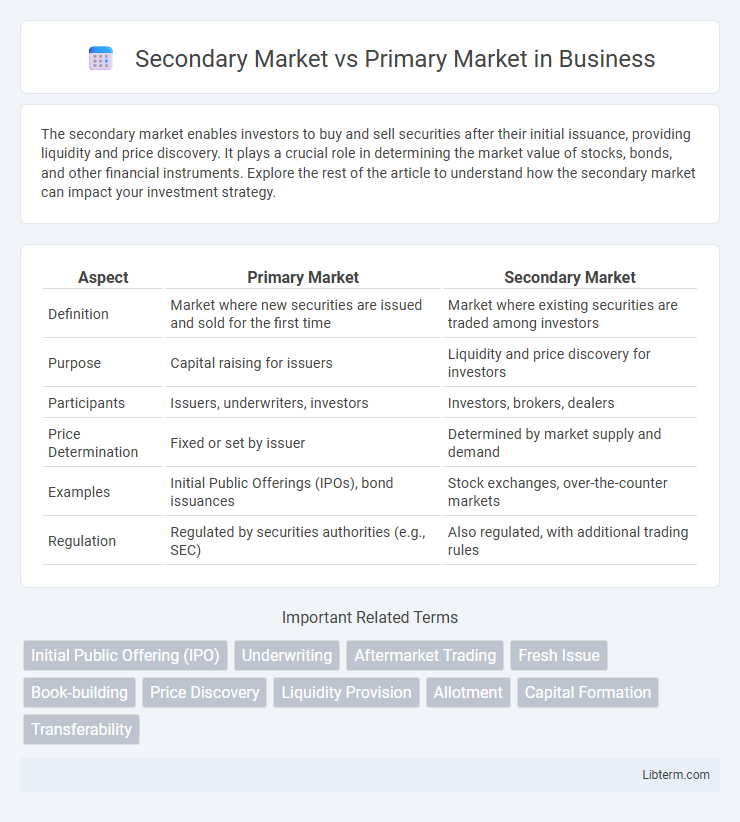The secondary market enables investors to buy and sell securities after their initial issuance, providing liquidity and price discovery. It plays a crucial role in determining the market value of stocks, bonds, and other financial instruments. Explore the rest of the article to understand how the secondary market can impact your investment strategy.
Table of Comparison
| Aspect | Primary Market | Secondary Market |
|---|---|---|
| Definition | Market where new securities are issued and sold for the first time | Market where existing securities are traded among investors |
| Purpose | Capital raising for issuers | Liquidity and price discovery for investors |
| Participants | Issuers, underwriters, investors | Investors, brokers, dealers |
| Price Determination | Fixed or set by issuer | Determined by market supply and demand |
| Examples | Initial Public Offerings (IPOs), bond issuances | Stock exchanges, over-the-counter markets |
| Regulation | Regulated by securities authorities (e.g., SEC) | Also regulated, with additional trading rules |
Introduction to Primary and Secondary Markets
Primary markets facilitate the initial issuance of securities directly from companies to investors, enabling capital formation and funding for growth. Secondary markets allow investors to buy and sell previously issued securities, providing liquidity and price discovery for financial assets. Together, these markets form the backbone of the financial ecosystem, supporting investment and capital flow.
Definition of Primary Market
The primary market is a financial market where new securities, such as stocks and bonds, are issued directly by companies or governments to investors for the first time through initial public offerings (IPOs) or private placements. It serves as a crucial platform for raising capital, enabling issuers to obtain funds for expansion, development, or debt repayment. Unlike the secondary market, where existing securities are traded among investors, transactions in the primary market result in fresh capital inflow to the issuer.
Definition of Secondary Market
The secondary market is a financial marketplace where investors buy and sell securities previously issued in the primary market, such as stocks and bonds. Unlike the primary market, where securities are created and sold for the first time, the secondary market facilitates liquidity and price discovery by enabling the exchange of existing financial instruments. Major examples of secondary markets include stock exchanges like the New York Stock Exchange (NYSE) and NASDAQ.
Key Differences Between Primary and Secondary Markets
Primary markets facilitate the initial issuance of securities directly from companies to investors, enabling capital raising through IPOs and private placements. Secondary markets involve the buying and selling of existing securities between investors, providing liquidity and price discovery through exchanges like the NYSE and NASDAQ. Key differences include transaction participants, with primary markets involving issuers and investors, while secondary markets focus on investor-to-investor trades, and the impact on capital flow, where primary markets inject funds into companies and secondary markets enable market efficiency and portfolio management.
Process of Issuing Securities in Primary Market
The primary market involves the initial issuance of securities directly from companies to investors, enabling firms to raise capital by offering new stocks or bonds through underwriting and public offerings. This process typically includes regulatory approval, pricing determination, and allocation of shares to investors during an initial public offering (IPO) or private placement. In contrast, the secondary market facilitates the buying and selling of existing securities among investors without involving the issuing company.
Trading Mechanisms in Secondary Market
The secondary market facilitates the trading of existing securities between investors through organized exchanges or over-the-counter platforms, enabling liquidity and price discovery. Trading mechanisms in the secondary market include order-driven systems, where buy and sell orders are matched based on price and time priority, and quote-driven systems, where market makers provide continuous bid and ask prices to ensure market liquidity. These mechanisms ensure efficient execution, transparency, and accessibility for investors seeking to buy or sell financial instruments after their initial issuance.
Role of Investors in Primary vs Secondary Market
Investors in the primary market purchase newly issued securities directly from issuers, providing crucial capital for companies and governments to fund projects and expansion. In contrast, the secondary market allows investors to buy and sell existing securities among themselves, offering liquidity and price discovery without additional capital flowing to the issuer. This distinction highlights the primary market's role in capital formation and the secondary market's function in market efficiency and investor flexibility.
Advantages of Primary Market
The primary market offers companies direct access to capital by issuing new securities, enabling efficient fundraising for growth and expansion. Investors benefit from purchasing shares at their initial offering price, often at a potential discount compared to secondary market prices. This market enhances price discovery and transparency as securities are introduced and regulated under strict compliance standards.
Benefits of Secondary Market
The secondary market offers enhanced liquidity by enabling investors to buy and sell securities quickly, supporting continuous price discovery and market efficiency. It provides opportunities for portfolio diversification and risk management, allowing investors to adjust holdings without issuing new securities. This market also facilitates capital flow by signaling demand and performance, helping issuers gauge investor interest and market conditions.
Primary and Secondary Markets: Impact on Economy
Primary markets facilitate capital formation by enabling companies to raise funds through initial public offerings (IPOs) or bond issuances, directly fueling business expansion and economic growth. Secondary markets provide liquidity by allowing investors to buy and sell securities, enhancing market efficiency and confidence, which encourages continuous investment. Together, these markets support economic stability and development by efficiently allocating resources and promoting financial market dynamics.
Secondary Market Infographic

 libterm.com
libterm.com